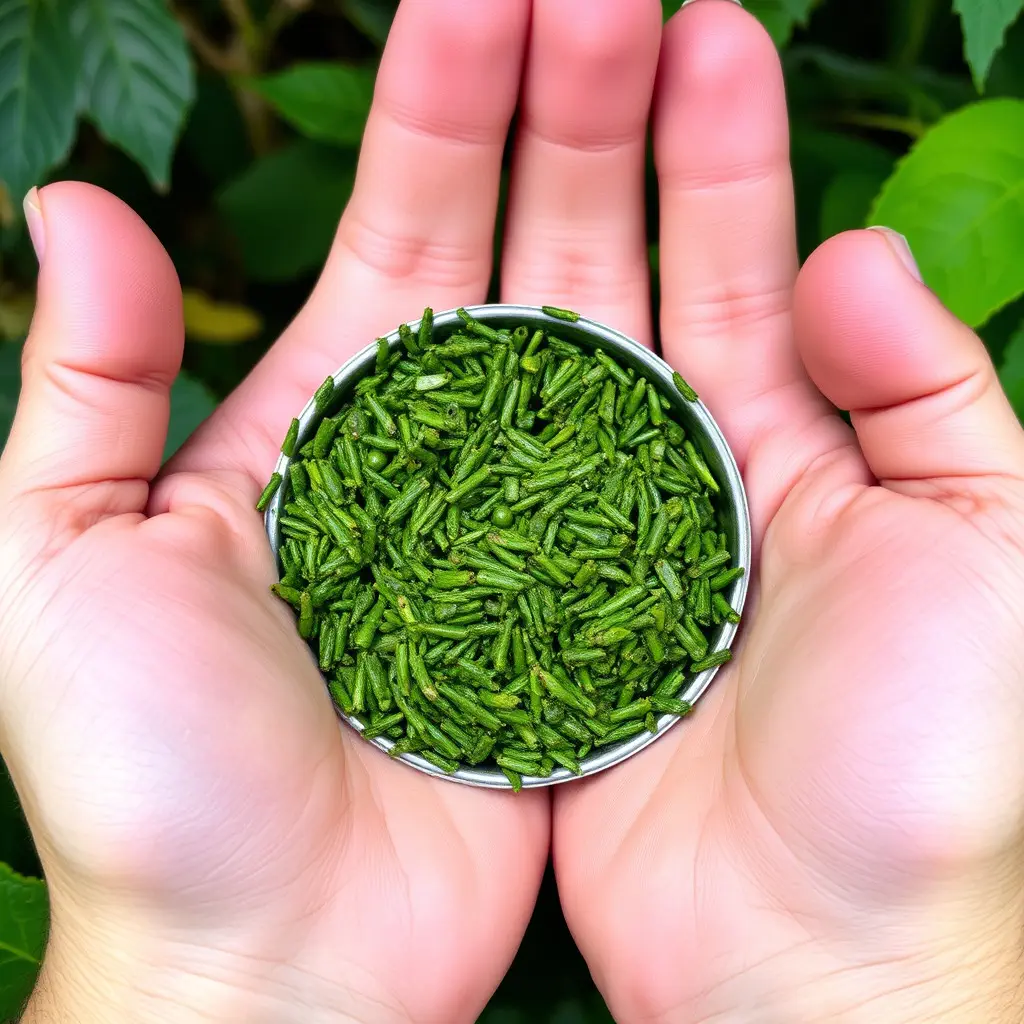Kratom, derived from Southeast Asia, is gaining attention as a natural alternative for managing chronic pain due to its psychoactive alkaloids like mitragynine and 7-hydroxymitragynine. These compounds offer analgesic effects by interacting with opioid receptors, potentially reducing dependency risks associated with synthetic opioids. However, users must consider the significant variations in individual responses to kratom, which can be influenced by dosage, strain selection, and personal biochemistry. Its legal status is inconsistent across regions, necessitating awareness of local regulations. The use of kratom for chronic pain management should be approached with caution, and individuals are advised to consult healthcare professionals for informed decision-making regarding its integration into their health regimen. This approach considers the potential benefits of kratom in pain relief while acknowledging the importance of a comprehensive and personalized treatment plan that includes monitoring and adherence to safe dosage practices. Regular updates on scientific understanding and regulatory changes are essential for responsible use.
Kratom has emerged as a subject of intrigue and debate within the realms of alternative medicine and chronic pain management. Its potential to alleviate pain and enhance well-being offers a compelling alternative for those struggling with persistent discomfort. This article delves into the multifaceted relationship between kratom and pain relief, exploring its phytochemical properties, the science behind its effects, and the practical considerations for its use. We will navigate the complex regulatory landscape surrounding kratom and provide guidance on how it may be safely integrated into a comprehensive chronic pain management strategy. Join us as we uncover the role of kratom in promoting overall well-being and resilience.
- Unraveling the Role of Kratom in Chronic Pain Management: An Overview of Its Potential Benefits and Considerations
- The Science Behind Kratom: Understanding Its Phytochemical Components and Effects on Well-Being
- Navigating Regulations and Responsible Use: A Guide to Safely Incorporating Kratom into Chronic Pain Management Strategies
Unraveling the Role of Kratom in Chronic Pain Management: An Overview of Its Potential Benefits and Considerations

Kratom, a plant native to Southeast Asia, has garnered attention in the realm of natural remedies for chronic pain management. Its leaves contain compounds that can interact with the brain and nervous system, providing pain-relieving effects. Users often report relief from persistent aches and discomforts, which can significantly enhance their quality of life. The alkaloids present in kratom, such as mitragynine and 7-hydroxymitragynine, are thought to be responsible for its analgesic properties. These compounds may modulate pain signals and promote a sense of well-being, which is crucial for individuals grappling with long-term pain conditions.
However, it’s important to approach the use of kratom with caution and a comprehensive understanding of its potential benefits and considerations. While kratom may offer relief from chronic pain, its effects can be highly variable between individuals. Factors such as dosage, strain, and personal physiology play significant roles in how one might experience its therapeutic or adverse effects. Additionally, the regulatory status of kratom varies by country and region, with some classifying it as a controlled substance due to concerns over dependency and abuse potential. As such, individuals considering kratom for chronic pain management should seek guidance from healthcare professionals and stay informed on the latest research and legal regulations surrounding its use.
The Science Behind Kratom: Understanding Its Phytochemical Components and Effects on Well-Being

Kratom, a tropical tree native to Southeast Asia, has garnered attention in various medical and wellness circles for its potential therapeutic properties, particularly in chronic pain management. The effects of kratom are attributed to its alkaloid profile, which includes mitragynine and 7-hydroxymitragynine, among others. These phytochemicals interact with the body’s opioid receptors, providing analgesic effects that can be beneficial for those suffering from persistent pain. Scientific research has begun to unravel the complex mechanisms by which kratom exerts its influence on pain perception, neurotransmitter release, and mood regulation, offering a natural alternative to traditional synthetic opioids. The alkaloids present in kratom leaves are believed to affect various neurological pathways, leading to both stimulating and sedative effects, depending on the dosage. This dual-action characteristic is particularly promising for individuals seeking relief from chronic pain without the high risk of addiction or adverse side effects associated with prescription opioids.
Furthermore, beyond its analgesic properties, kratom’s impact on well-being extends to its potential to enhance mental clarity and promote a state of calmness. The modulation of neurotransmitters like serotonin and norepinephrine by kratom alkaloids may contribute to its use as an adjunct in managing conditions such as depression and anxiety. The holistic approach of incorporating kratom into well-being practices is supported by anecdotal evidence and emerging scientific research, suggesting its role in improving overall health and fostering resilience against stressors. As with any supplement or medication, it is crucial for individuals to consult healthcare professionals before integrating kratom into their health regimen, ensuring safe and effective use based on individual health needs and conditions.
Navigating Regulations and Responsible Use: A Guide to Safely Incorporating Kratom into Chronic Pain Management Strategies

Kratom, a plant from Southeast Asia with leaves that contain compounds that can have effects similar to opioids, has garnered attention as an alternative for chronic pain management. As individuals seek natural solutions to alleviate persistent discomfort, understanding how to navigate the regulations and use kratom responsibly is paramount. The legal status of kratom varies by region, with some areas imposing strict controls due to its potency and potential for abuse. It is crucial for those considering kratom as part of their pain management strategy to first familiarize themselves with local laws and regulations. This ensures compliance and avoids unintended legal consequences.
When integrating kratom into chronic pain management, responsible use cannot be overstated. Users must approach it with caution, adhering to recommended dosages and being mindful of the interaction with other medications. The efficacy of kratom can be influenced by various factors, including strain potency, individual body chemistry, and the specific type of chronic pain being experienced. Regular monitoring of both pain levels and kratom’s effects is essential for safe and effective management of chronic pain. It is also advisable to consult with healthcare professionals who can provide guidance tailored to individual needs, ensuring that kratom use is part of a holistic and balanced approach to well-being and resilience.
Kratom’s potential as a component in chronic pain management strategies warrants careful consideration, with its benefits and risks thoroughly evaluated. The phytochemical makeup of kratom, as explored, suggests a promising avenue for improving well-being, particularly for those grappling with persistent pain. Navigating the regulations surrounding its use ensures responsible consumption, aligning with the broader aim of holistic health management. In light of the evidence presented, it is clear that kratom, when used judiciously and within legal frameworks, can be a valuable tool in the multifaceted approach to pain relief and enhancing overall resilience. Users are advised to consult healthcare professionals for personalized guidance and to stay informed on the evolving landscape of kratom research and policy.






